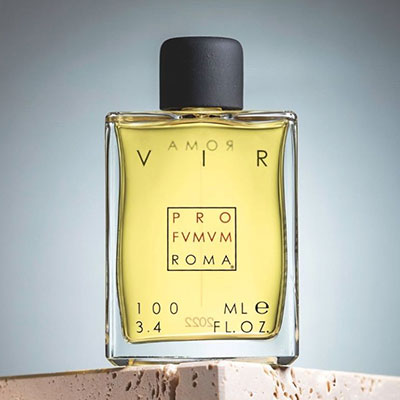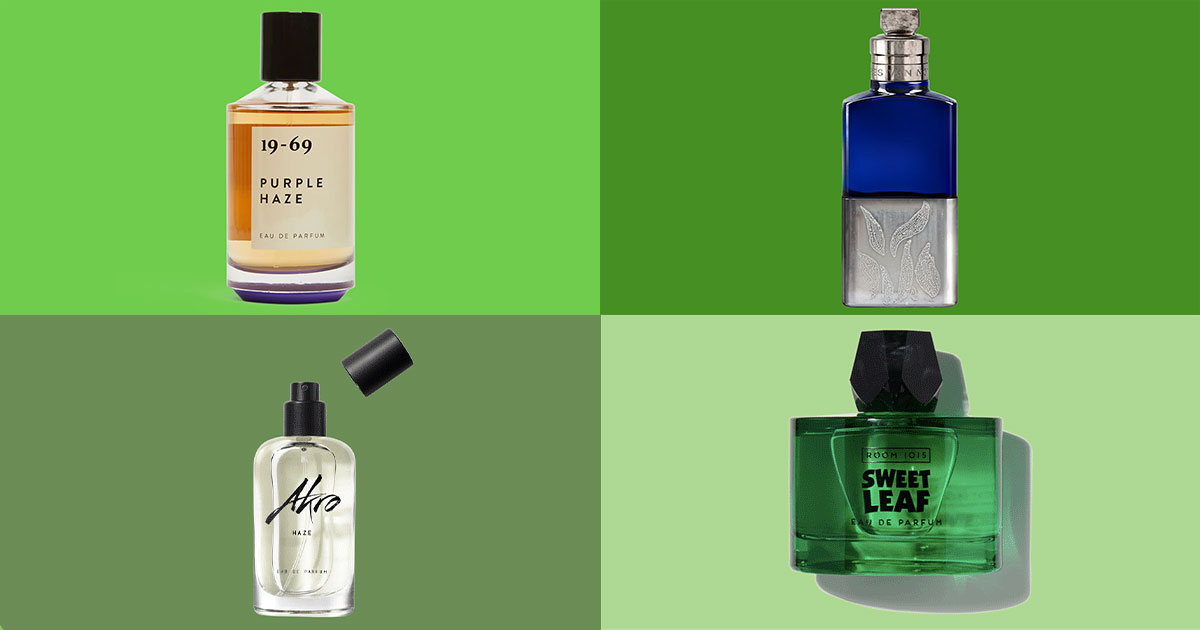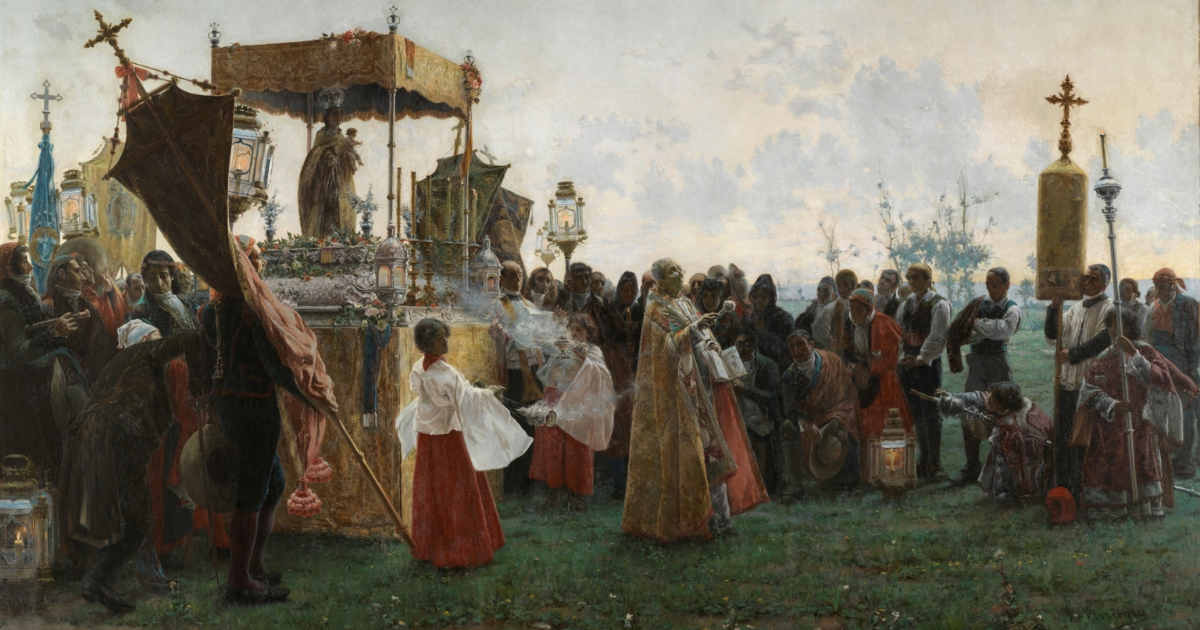Cette publication est également disponible en :
Français
The last few years have seen an increasing number of creations inspired by marijuana, whether it’s the excitement of the forbidden or the semi-guilty pleasure of rediscovering its heady scent. An overview of the olfactory interpretations of the plant, as seen through the eyes of perfumers Olivier Cresp (Firmenich) and Nicolas Beaulieu (IFF).
The dried flowers are known as marijuana (or grass, kif, ganja, weed), while the compressed resin is called hashish (or hash, shish, black ganga). Whatever the term, Cannabis sativa (the botanical name for hemp), which belongs to the Cannabaceae family, is a flowering plant covered in feathery hairs, with large green serrated palmate leaves and a straight, grooved stem with different degrees of branching. Mostly dioecious (i.e. sexed: there are male and female plants), the plant is wind-pollinated. It is highly resistant and adapts to most climates, although it prefers hot areas and calcareous and nitrate-rich soils.
Psychoactive substances and terpenic compounds
There are three varieties, which have been crossed to produce numerous hybrids. Cannabis sativa sativa, native to temperate and equatorial regions, is grown for its fibre and oil seeds. It is used for textiles and contains no psychotropic molecules. Cannabis sativa indica, or Indian hemp, is smaller and less fibrous and is grown in hot countries. To protect itself from drought, it produces a resin rich in psychoactive substances, particularly 9-tetrahydrocannabinol (THC). Cannabis sativa ruderalis, which is less common, is low in THC but flowers faster.
The plant contains several hundred different molecules: essential oils rich in terpene compounds, flavonoids, sugars, fatty acids and cannabinoids, including THC and cannabidiol (CBD).
The THC and CBD content is used to distinguish between types of cannabis. They are considered “fibres” when the THC content is under 0.2% and as “drugs” when the THC content is over 0.3%. THC content is not only a matter of variety: it also differs according to climatic and growing conditions. In temperate zones, for example, it does not exceed 2 to 3%, while in hot zones it can rise to 30%.
Therapeutic use
Cannabis was first used for its fibres over 10,000 years ago in the manufacture of ropes and textiles. But its therapeutic use also has a long history, dating back to the 4th century BCE. However, when Pliny the Elder mentions hemp, he is referring to Althaea cannabina, or hemp-leaved hollyhock. The use of cannabis as a drug did not become popular in the West until the 19th century, under the influence of intellectual circles such as the Haschischins club in Paris, frequented by artists like Théophile Gautier. But it was quickly banned: doctors and pharmacists who wanted, in particular, to protect their therapeutic monopoly, worked to gradually obtain exclusive use of cannabis in the early 1900s, which led to the Marihuana Tax Act of 1937 in the United States. The act was gradually extended to other countries around the world.
The recent legalisation of cannabis in various countries and, more generally, the opening of the CBD shops which have been flourishing in cities for several years, have helped to bring the plant back into the limelight. The sale of this non-psychotropic product, which has been tolerated since 2020 following an opinion issued by the European Commission, which recognised that it is not a narcotic drug, has however remained in legal limbo in France. The ministerial decree of 31 December 2021, which approved its production and marketing in France, at the same time prohibited the sale of marijuana flower and leaf, giving the CBD sector a fright. Then the Council of State suspended it on Monday 24 January 2022, much to the delight of all the newly established shops. Last May, the Robertet composition house announced that it had started producing CBD locally.
The trend has also recently taken root in the cosmetics industry. Some companies, such as Ho Karan, a pioneering hemp specialist created in 2015, have built their range around the plant with its many dermatological qualities. And then there are all the non-specialist brands which have also, more or less recently, launched a product boasting cannabis as an ingredient, from The Body Shop to Mira, Nivea to Typology, and including a dedicated collection at Sephora.
A complex smell
In perfumery, cannabis has been inspiring compositions for several years: “It’s a very complex scent, with facets that are fruity, sparkling, warm and pungent…and I particularly like working on its sulphurous notes. It’s part of the general trend for aromatics, which is where I personally would categorise it. And then, the cannabis accord brings out a perfume’s qualities, it’s very familiar, overpowering and identifiable; but it can also have a marketing role, especially in the niche sector, with the way it evokes the subversive. Nevertheless, brands often prefer not to mention it in their press kit, even if the accord is olfactory,” says Nicolas Beaulieu, senior perfumer at IFF and the creator of Voodoo Chile for Dries van Noten (see below).
However, the smell of illicit smoke, a source of fantasy and of a very particular appeal, “is not available as an extract in our palette,” explains Olivier Cresp of Firmenich, founder of the Akro brand (see below). The accord therefore has to be entirely reconstructed. The plant’s main olfactory compounds are terpenes, also found in aromatic plants such as thyme and mint. “Having lived in the Netherlands for a long time, I can say that there is not just one weed aroma. But I have composed a base accord for a museum centring on sage, grapefruit and smokier and more resinous notes and volatile sulphurous bodies,” explains Nicolas Beaulieu. The floral top notes, on the other hand, are far more herbaceous and earthy.
Olivier Cresp prefers the smell of resin with its camphorated sillage, which takes on spicier or more plastic-like accents depending on the substance used to cut it: “The smell is powerful, it takes you by storm, I love it. It’s mainly the niche brands that ask for it, as an overdose in a central accord. The constructions are different for mainstream perfumery, I’m often asked to take the accord down a notch. They are two different and complementary ways of composing.” As for the cannabis fields, “they have a fresh smell, reminiscent of cucumber and violet.”
Scented inspirations
While one of the first fragrances to claim a cannabis accord was Lamborghini’s Kif in 1980 – building on the success of Opium, launched in 1977 – it wasn’t until the 2000s that the note began to gain popularity in the industry. In 2002, Pierre Guillaume’s Cozé explored an oriental dream world with a spicy and woody composition. A year later, L’Eau Argentine by Iunx was released as the “eau for the wise” (unfortunately no longer available), with Olivia Giacobetti distilling a poetic hemp infused with rice and maté. In 2009, Alessandro Gualtieri devised Black Afgano for his brand Nasomatto, a oud- and tar-fuelled fragrance inspired by the much sought-after hashish of the same name. This was followed by Smoke for the soul, created by Fabrice Pellegrin for By Kilian in 2014, a more aromatic and herbal perfume. The same year saw the release of Junky by Jardins d’écrivains, created by Anaïs Biguine in homage to Beat Generation author William Burroughs, who talked about his addiction in his novels, and I Love You, Mary Jane by DSH Perfumes, Dawn Spencer Hurwitz’s brand, described as “a deliciously fruity version of the cannabis note, the sticky sweetness revealing its brilliance and beauty.”
In 2017, Maison Martin Margiela expanded its Replica collection with Music Festival, enveloping the leaf in “fresh bud notes combined with incense oil and a leathery accord” to offer us a “true invitation to escape reality.”

With the launch of 19-69 (pronounced nineteen sixty-nine), Swedish artist Johan Bergelin went in the same direction with Purple Haze, which aims to “embrace the hippie movement and counterculture”, recreating the atmosphere of the Woodstock festival, whose date gave the brand its name. The cannabis accord is arrayed in violet leaf and patchouli. With Chronic, launched more recently, Amélie Bourgeois enfolds the leaf in a bitter grapefruit and a moss accord to “pay homage to the cannabis culture in Southern California in the 1990s”. Orange Kush, on the other hand, is a nod to “the origins of skateboarding” with its mix of hemp, sweet orange and mandarin flower. While Higher Peace invites you to “take your mind on a journey” with a “hempy, sharp, Play-Doh-like” composition. Quite a programme!

In 2018, it was Olivier Cresp’s turn: along with his daughter, he launched the Akro brand, which bottles up various addictions. Cannabis stands front and centre in Haze. “My perfumes are figurative, not abstract. I tried to reproduce the smell of cannabis and then make a fragrance that people would enjoy wearing. Of our seven fragrances, this was the most obvious choice, as it’s a smell I love, I can spot it from a distance, and for me it’s really extraordinary, especially in its resinous form, with its spicy and aromatic notes. I use wormwood essence to get that slightly bitter, yeasty aspect. I used clary sage, mugwort for its aromatic aspect, and a special type of eucalyptus, which hints at perspiration. I also used spearmint, because I found it had cannabis facets in my infusions! And then legal sulphurous notes – no naughty notes, nothing illegal! But with an extremely intense dosage, because we can get away with it in niche perfumery. And there are some very nice sulphurous molecules at Firmenich. Finally, to round it out and make it lovely to wear, I worked on a more woody, musky structure, which has real sillage and staying power,” explains the perfumer.

The following year, the brand Bois 1920 followed suit by dedicating three fragrances to the plant. Cannabis was joined by a fruity version (Cannabis Fruttata) and a savoury version (Cannabis Salata), all by Cristian Calabro.

In November 2021, Comme des garçons introduced Ganja, created by Caroline Dumur of IFF. The fragrance evokes “the extrasensory world through its spicy and airy woody aroma”, designed around a cannabis accord, maté, spices, and its favourite companion, patchouli.

A month later, Lush used its 4:20pm bath bomb, named after slang for marijuana consumption, as the basis for a “CBD-infused” massage bar and fragrance. The accord, attributed to the brand’s founder, Mark Constantine, is swathed in “earthy notes of sandalwood and patchouli.”

“4:20 am, still on the road”, announces the press kit for Room 1015. Founded as a tribute to 1970s rock’n’roll, the brand naturally offers its own interpretation of the green leaf. In Sweet Leaf, released in 2021, Serge De Oliveira blends it with grapefruit, eucalyptus, jasmine and angelica to distil “the scent of a colourful journey with no final destination” promising to “make us float.”

A cannabis note also featured in two of the ten perfumes launched last April by Dries van Noten. Explicitly and classically in Cannabis Patchouli by Nicolas Bonneville of Firmenich, and more innovatively in Voodoo Chile by IFF’s Nicolas Beaulieu, who blends it with fresh rhubarb.
“I wanted to reproduce the smell of the skin after smoking. I worked on a rosemary-patchouli accord with resinous notes, a beautiful hay absolute from LMR, lentisk, and cumin facets. There’s also a hint of blackcurrant, but not the buds, which are a bit too fruity; it’s more like oxane. And a grapefruit facet, with sulfur-limonene and methyl grapefruit.”

Finally we have Profumum Roma, building its interpretation of cannabis on wood, incense, tobacco leaves and oud with the recently launched Vir, a fragrance that conjures up a face-to-face encounter with ourselves as we carry “the weight of emotions, failures and resurrections”.

The trend was only going to get stronger once the mainstream market picked up on the note. As it did in May 2022 with Habit rouge L’instinct. Guerlain describes it as “an aromatic, herbaceous hemp that evokes the bitterness of grapefruit, textured like horsehair.” It nevertheless has a very, very discreet olfactory presence.

And the note keeps on inspiring perfumers. While Olivier Cresp would like to propose a new approach “based on marigold notes, with spicier, peppery facets, and perhaps a hint of violet”, Nicolas Beaulieu is looking to a possible vetiver-cannabis combination: “I’d like to work on nootkatone, which is found in the white, bitter part of the grapefruit and in vetiver.”
With the rise of the trend for functional fragrances, composed to influence our well-being, and where CBD could be a key element, we can only hope that their wishes will be fulfilled – without going up in smoke!
To learn more about cannabis in perfumery, you can also read our addictive substances feature in Nez, the Olfactory Magazine – #08, and analysis of the smell of drugs in Nez, the Olfactory Magazine – #04.








The article is very interesting and I am interested on more info about scent and tends to is a personal thrill and passion
Thank you